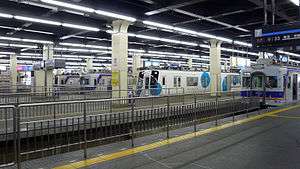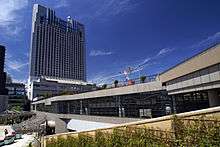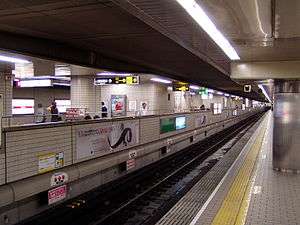Namba Station
Namba Station (難波駅, なんば駅, Nanba-eki) is a name shared by two railway stations in the Namba district of Chūō-ku, Osaka, Japan. One is owned by Nankai Electric Railway,[1] while the other is by the Osaka Metro. The names of both stations are written in hiragana on signage within the stations, because the kanji "難波" can be also read "Naniwa". However, the name of both stations officially employs kanji, printed on train tickets.
Namba Station 難波駅 | |
|---|---|
| Location | Osaka, Osaka Japan |
| Operated by | |
| Connections | Bus stop Taxi stand Ōsaka Namba Station JR Namba Station |
| History | |
| Opened | 1935 |
| Location | |
 Namba Station Location within Japan | |
They are close to JR Namba Station and Ōsaka Namba Station.
Lines
- Nankai Electric Railway (NK01)[1]
- Nankai Main Line
- Nankai Koya Line
- Osaka Metro
- Midōsuji Line (M20)
- Sennichimae Line (S16)
- Yotsubashi Line (Y15)
- Connecting Stations
- Ōsaka Namba Station (renamed from Kintetsu Namba Station in 2009)
- Kintetsu Namba Line
- Hanshin Namba Line
- JR Namba Station (renamed from Minatomachi Station in 1994)
Nankai Electric Railway
Namba Station 難波駅 | |
|---|---|
| Nankai Electric Railway station | |
 Nankai station platforms, with several trains waiting at different platforms | |
| Location | 1-60, Namba Gochōme, Chūō, Osaka, Osaka (大阪市中央区難波五丁目1-60) Japan |
| Coordinates | 34°39′48.28″N 135°30′6.88″E |
| Operated by | Nankai Electric Railway Co., Ltd.[1] |
| Line(s) |
|
| Platforms | 16 (7 island platforms, 2 side platforms) |
| Tracks | 9 |
| Connections | Bus stop[1] Taxi stand[1] Ōsaka Namba Station JR Namba Station |
| Other information | |
| Station code | NK01[1] |
| History | |
| Opened | 29 December 1885[1] |
Namba Station (Nankai) layout | ||||||||||||||||||||||||||||||||||||||||||||||||||||||||||||||||||||||||||||||||||||||||||||||||||
|---|---|---|---|---|---|---|---|---|---|---|---|---|---|---|---|---|---|---|---|---|---|---|---|---|---|---|---|---|---|---|---|---|---|---|---|---|---|---|---|---|---|---|---|---|---|---|---|---|---|---|---|---|---|---|---|---|---|---|---|---|---|---|---|---|---|---|---|---|---|---|---|---|---|---|---|---|---|---|---|---|---|---|---|---|---|---|---|---|---|---|---|---|---|---|---|---|---|---|
| ||||||||||||||||||||||||||||||||||||||||||||||||||||||||||||||||||||||||||||||||||||||||||||||||||

Layout
There are nine bay platforms with eight tracks on the third floor. Nankai Terminal Building is located in front of the station. Ticket gates are located in the north of the platform, in the center on the second floor and in the south on the second floor.
- Nankai Koya Line - for Gokurakubashi (change for Koyasan) and (Semboku Rapid Railway) Izumi-Chuo
| 1 | ■ Nankai Koya Line | mainly Local trains |
| 2 | ■ Nankai Koya Line | mainly Semi-Express to Semboku Rapid Railway some Express, Rapid Express and Sub. Express in the peaks |
| 3 | ■ Nankai Koya Line | mainly Limited Express, Express, Sub. Express and Rapid Express |
| 4 | ■ Nankai Koya Line | mainly Limited Express, Express, Sub. Express and Rapid Express |
- Nankai Line and Airport Line - for Wakayamashi and Kansai Airport
| 5 | ■ Nankai Line and Airport Line | mainly Limited Express, Express, Sub. Express and Airport Express |
| 6 | ■ Nankai Line and Airport Line | mainly Limited Express, Express, Sub. Express and Airport Express |
| 7 | ■ Nankai Line and Airport Line | mainly Local trains |
| 8 | ■ Nankai Line and Airport Line | occasionally used for Local trains |
| 9 | ■ Airport Line | Airport Limited Express Rapi:t |
Adjacent stations
| « | Service | » | ||
|---|---|---|---|---|
| Nankai Main Line (NK01) (No trains stop at Imamiyaebisu and Haginochaya) | ||||
| Terminus | Limited Express Rapi:t Limited Express Southern |
Shin-Imamiya (NK03) | ||
| Terminus | Express | Shin-Imamiya (NK03) | ||
| Terminus | Airport Express | Shin-Imamiya (NK03) | ||
| Terminus | Sub. Express | Shin-Imamiya (NK03) | ||
| Terminus | Semi-Express (terminating) | Shin-Imamiya (NK03) | ||
| Terminus | Local | Shin-Imamiya (NK03) | ||
| Koya Line (NK01) | ||||
| Terminus | Limited Express Koya Limited Express Rinkan Limited Express Semboku Liner |
Shin-Imamiya (NK03) | ||
| Terminus | Rapid Express | Shin-Imamiya (NK03) | ||
| Terminus | Express | Shin-Imamiya (NK03) | ||
| Terminus | Sub. Express | Shin-Imamiya (NK03) | ||
| Terminus | Semi-Express | Shin-Imamiya (NK03) | ||
| Terminus | Local | Imamiyaebisu (NK02) | ||
Osaka Metro
Namba Station なんば駅 | |
|---|---|
| Osaka Metro station | |
 Midōsuji Line platforms | |
| Other names | Nankai Namba Station |
| Location | Namba Nichōme, Chūō-ku Namba Sanchōme, Chūō-ku Motomachi Itchōme, Naniwa-ku Osaka, Osaka (大阪市中央区難波二丁目・難波三丁目 大阪市浪速区元町一丁目) Japan |
| Coordinates | 34°39′58.74″N 135°30′1.13″E (Midosuji Line) 34°40′1.69″N 135°30′1.03″E (Sennichimae Line) 34°39′55.4″N 135°29′52.53″E (Yotsubashi Line) |
| Operated by | Osaka Municipal Transportation Bureau (Municipal Subway) |
| Line(s) | |
| Platforms | Midōsuji Line: 3 (1 island platform, 1 side platform) Yotsubashi Line: 2 (1 island platform) Sennichimae Line: 2 (1 island platform) |
| Tracks | Midōsuji Line: 2 Yotsubashi Line: 2 Sennichimae Line: 2 |
| Construction | |
| Structure type | Underground |
| Other information | |
| Station code | M20 (Midōsuji Line) Y15 (Yotsubashi Line) S16 (Sennichimae Line) |
| History | |
| Opened | 30 October 1935 |
| Traffic | |
| Passengers (FY2016) | 343,016 daily[2] |
Namba Station (Osaka Municipal Subway) layout | ||||||||||||||||||||||||||||||||||||||||||||||||||||||||||||||||||||||||||||||||||||
|---|---|---|---|---|---|---|---|---|---|---|---|---|---|---|---|---|---|---|---|---|---|---|---|---|---|---|---|---|---|---|---|---|---|---|---|---|---|---|---|---|---|---|---|---|---|---|---|---|---|---|---|---|---|---|---|---|---|---|---|---|---|---|---|---|---|---|---|---|---|---|---|---|---|---|---|---|---|---|---|---|---|---|---|---|
Midōsuji Line (M20) | ||||||||||||||||||||||||||||||||||||||||||||||||||||||||||||||||||||||||||||||||||||
| ||||||||||||||||||||||||||||||||||||||||||||||||||||||||||||||||||||||||||||||||||||
Sennichimae Line (S16) | ||||||||||||||||||||||||||||||||||||||||||||||||||||||||||||||||||||||||||||||||||||
| ||||||||||||||||||||||||||||||||||||||||||||||||||||||||||||||||||||||||||||||||||||
Yotsubashi Line (Y15) | ||||||||||||||||||||||||||||||||||||||||||||||||||||||||||||||||||||||||||||||||||||
| ||||||||||||||||||||||||||||||||||||||||||||||||||||||||||||||||||||||||||||||||||||
Layout
Midōsuji Line
- An island platform and a side platform with two tracks.
| 1 | ■ Midōsuji Line | for Tennoji, Abiko, and Nakamozu |
| 2 | ■ Midōsuji Line | for Umeda, Shin-Ōsaka, Esaka, and Senri-Chūō |
The Midōsuji Line station originally opened as an island platform serving two tracks, but overcrowding prompted construction of a side platform serving northbound trains (that platform opened in 1987). As of 2015, the island platform serves only southbound trains, and the northbound side of the island platform is fenced off.
Sennichimae Line
- An island platform with two tracks
| 3 | ■ Sennichimae Line | for Tsuruhashi and Minami-Tatsumi |
| 5 | ■ Sennichimae Line | for Nodahanshin |
Yotsubashi Line
- An island platform with two tracks
| 1 | ■ Yotsubashi Line | for Daikokucho and Suminoekoen |
| 2 | ■ Yotsubashi Line | for Nishi-Umeda |
 Ticket gates
Ticket gates Sennichimae Line platforms
Sennichimae Line platforms Yotsubashi Line platforms
Yotsubashi Line platforms
Adjacent stations
| « | Service | » | ||
|---|---|---|---|---|
| Midōsuji Line (M20) | ||||
| Shinsaibashi (M19) | - | Daikokucho (M21) | ||
| Sennichimae Line (S16) | ||||
| Sakuragawa (S15) | - | Nippombashi (S17) | ||
| Yotsubashi Line (Y15) | ||||
| Yotsubashi (Y14) | - | Daikokucho (Y16) | ||
History
The Nankai Electric Railway station opened on 29 December 1885.[3] The Osaka Subway Midosuji Line station opened on 30 October 1935, the Yotsubashi Line station opened on 1 October 1965, and the Sennichimae Line opened on 11 March 1970.[3]
Surrounding area
- Takashimaya
- Namba City
- Namba Walk
- Namba Parks
- Swissôtel Nankai Osaka
- Namba Expressway Bus Terminal
- Osaka City Air Terminal (OCAT)
- Parks Tower (Namba Parks)
- Bic Camera
- Minatomachi River Place (including FM OSAKA)
- Namba Grand Kagetsu
- Nankai Electric Railway headquarters
- Osaka Prefectural Gymnasium
- Ebisubashi Shopping Arcade
- NMB48
See also
References
- なんば駅|南海電鉄. www.nankai.co.jp (in Japanese). Nankai Electric Railway. Retrieved 9 March 2017.
- "路線別駅別乗降人員" (PDF). Osaka Municipal Transportation Bureau. November 8, 2016. Archived from the original (PDF) on April 1, 2017. Retrieved May 6, 2017.
- Terada, Hirokazu (19 January 2013). データブック日本の私鉄 [Databook: Japan's Private Railways] (in Japanese). Japan: Neko Publishing. pp. 283–287. ISBN 978-4-7770-1336-4.
External links
| Wikimedia Commons has media related to Namba Station. |
- Nankai Electric Railway station information (in Japanese)
- Namba - Osaka Metro station Midosuji Line (in Japanese)
- Namba - Osaka Metro station Sennichimae Line (in Japanese)
- Namba - Osaka Metro station Yotsubashi Line (in Japanese)